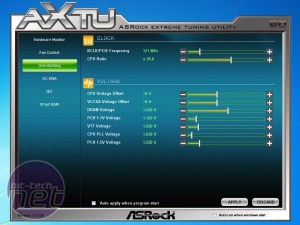
Performance
At stock speed, the Extreme4-M managed to outperform all the other LGA2011 boards we've tested in several of our benchmarks. It came top in the multi-tasking test, with a score of 1,515 – nearly 70 points faster than the Sabertooth X79. It also came second in the GIMP image editing test, with a score of 1,719 – over 40 points faster than its larger sibling, the Extreme4. Overall, it claimed first position with a score of 2,311 – nearly 60 points clear of the Intel DX79SI. Its minimum frame rate of 80fps in Arma II was right on the money too, with very little variation between the boards, and its Intel SATA 6Gbps ports maxed out the read and write speeds of our 240GB OCZ Vertex 3 SSD. The ASMedia SATA 6Gbps controller wasn’t nearly as fast, however, topping out with a 402MB/sec read and 364MB/sec write speed.Meanwhile, the EFI felt very snappy and responsive without a hint of lag, which can ruin even the best laid-out and well-featured EFIs. Switching to manual overclocking mode, we found that the CPU power limits had already been raised to levels that would enable us to push our CPU unhindered, although there’s no manual CPU strap adjustment. In the end, we settled on a CPU Base Clock of 121MHz using a CPU multiplier of 39x to result in a CPU frequency of 4.72GHz. Stabilising this overclock required a vcore of 1.4V and a VCCSA voltage of 1.02V.
We then headed back into Windows to play with ASRock’s Extreme Tuning Utility. The interface might look dated but it’s a decent tool for monitoring and tweaking your PC, and provides the full range of voltage and frequency tuning – albeit without CPU strap adjustment. This is also where you can alter the various fan profiles, including the one for the Southbridge fan.
The high CPU Base Clock and CPU frequency resulted in significant gains in all our tests. Its finest moments were in the HandBrake H.264 video encoding test, where its score of 4,805 was just five points off the top spot and a notable 135 points more than the Intel DX79SI, which came last.
Overall, the Extreme4-M came first yet again in our Media Benchmarks when overclocked, but with all boards except the Intel DX79SI managing CPU frequencies in the region of 4.7GHz, there was very little between them. This was also true in Arma II, where the majority of the boards managed a minimum frame rate of 85fps once overclocked.
Conclusion
Everyone was impressed by the ASRock X79 Extreme4-M as it has so many cool features packed into its tiny PCB. It also costs significantly less than any of the other LGA2011 boards we've tested – at just £160, this may very well prove tempting, especially when boards such as Asus’ Sabertooth X79 cost around £90 more. However, we wouldn’t recommend building an LGA2011 system in a micro-ATX case unless it had exceptional airflow, or you were water-cooling the motherboard and CPU.
The VRMs on all the LGA2011 boards we've tested become very hot and will throttle the CPU if pushed too far. Asus’ Sabertooth X79 also has eight DIMM slots, manual CPU strap adjustment, and even better tweaking and monitoring software, in addition to fans on both the VRMs and Southbridge. We wouldn’t discount the Extreme4-M, but make sure you’re aware of the LGA2011 platform’s thermal output before you reach for your wallet.
-
Value22 / 25
-
Features20 / 30
-
Speed41 / 45


MSI MPG Velox 100R Chassis Review
October 14 2021 | 15:04









Want to comment? Please log in.